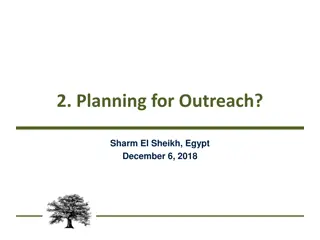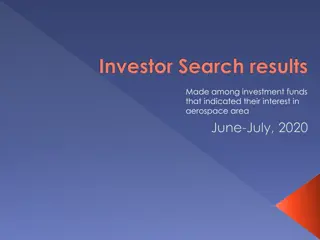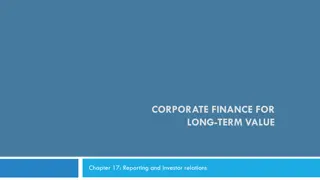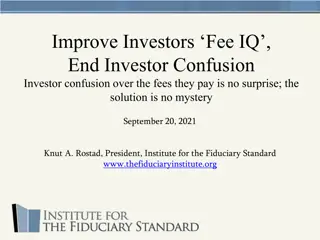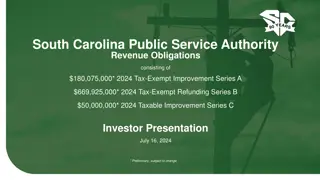Investor Presentation Best Practices for Success
Crafting a successful investor presentation involves addressing key aspects such as the company's mission, team background, problem statement, solution, and more. By focusing on clarity, conciseness, and confidence, entrepreneurs can effectively convey their message to potential investors and secure the funding needed for their venture.
Download Presentation

Please find below an Image/Link to download the presentation.
The content on the website is provided AS IS for your information and personal use only. It may not be sold, licensed, or shared on other websites without obtaining consent from the author.If you encounter any issues during the download, it is possible that the publisher has removed the file from their server.
You are allowed to download the files provided on this website for personal or commercial use, subject to the condition that they are used lawfully. All files are the property of their respective owners.
The content on the website is provided AS IS for your information and personal use only. It may not be sold, licensed, or shared on other websites without obtaining consent from the author.
E N D
Presentation Transcript
The Pitch/Investor Presentation Template David Michael Blumenstein Web: tekworks.david.com Email: tekworks@david.com A SLIDE BY SLIDE EXAMINATION OF THE PRESENTATION S CONTENT and MESSAGING, and WHAT IT SAYS ABOUT YOUR COMPANY AND YOU.
The Basics The presentation should answer more questions than it raises. The presentation should raise one s curiosity, not confuse or confound. There should be no mistake that the presentation is asking for money to be invested. What the company plans to with the money is equally as important as the company s mission. The deck can short, it can be long, but what itMUST do is succeed on its primary objective: to convince investors to invest.
The Intangibles The presentation should serve as an inventory/checklist of what has been accomplished and what remains to be done. The process should alert the team to its resource readiness and personnel capabilities. The presentation serves as a mirror image of the company: how it thinks, how it prioritizes, how it is capable of selling to an audience and the marketplace.
The Tips Establish a perimeter: do not go far afield from the mission statement and work within the team s proscribed boundaries. Speak in phrases, not sentences or paragraphs. Pace is important. Make sure to allow enough time for the most important and vital aspects of the presentation. Confidence is key. Presenting confidently makes investors feel more confidently about pulling the trigger on investing in your company.
The Outline Part 1: ASSETS What is the name of the company? Possibly include the name of the service/product - 1 slide What is the company s mission statement? Singular impact statement 1 slide Who comprises the team? Relevant background and experience 1 slide These first three slides should take no longer than 30 seconds to sail through. The background for team information should be self-explanatory and it would be a nice touch to add thumbnail photos of the core team members.
The Outline Part 2a: PROBLEM What is the issue/pain that the company is looking to address/resolve? Make it painful Make sure that a market and an audience exist to embrace the product/service What is the solution to this issue/pain? Employ use cases and scenarios How the solution works in practice NOT theory Make use of graphical representations Storyboards, Screenshots, Diagrams, Flow Charts, etc.
The Outline Part 2b: SOLUTION This section may take as few as five slides or as many as fifteen to demonstrate the solution and its applicability the problem it is looking to solve. Prodigious use of a remote control [clicker] to advance slides at a rapid pace can provide a sense of action to the presentation as the solution unfolds before the audience s eyes. The solution slide set is crucial to the presentation. These slides will stay in the minds of the audience as the presentation proceeds. Audience, Market Competitive Analysis Financials Ask Use of Proceeds
The Outline Part 3: MARKET What is the market size? How much of the market is addressable? What is the route to the market? What is the cost of customer acquisition? What is the customer acquisition plan of attack? Is the company aware of it customer demographics? Make the responses to these slides truly comprehensive 2 slides
The Outline Part 4: COMPETITION What is the look of the competitive landscape? Who is/are the competition? Are they really competitors? Could they be prospective partners? Could they be strategic partners Make use of a matrix: a chart demonstrating comparison of feature sets. Understand to whom the company is being compared to and that there are enough comparative data points.
The Outline Part 5: CUSTOMERS & REVENUE What is the company s present revenue? Are there existing customers? Are there prospects in the pipeline? Show logos of existing customers as well as prospects 2 slides What is the business model? What are the revenue streams? Distinguish between the two clearly, they are indeed different 1 slide
The Outline Part 6: FINANCIALS What are the company financials? What are the company projections? Provide a financial history of the company and a ledger sheet with G/L/A, revenue, expenses, operating costs, net income, and EBITDA The financials should not be so granular that they do not fit on one slide. Endeavor to make it readable and note, if there is anywhere in the presentation where will investors will trip you up, this is it. They are investors after all. Investors may not understand your product/service, but they do understand FINANCIALS.
The Outline Part 7: FINANCIALS What are the supporting materials for the financials? Explain the origin of the numbers. How were they derived? Highlight events along the projection cycle: (use the spreadsheet template in Part 7a) Break-even Profitability Sales inflections What is the funding request in $/ / What is the investment size? One lump sum? Or in tranches? What are the milestones and objectives? Speak clearly to the milestones and objectives. Be precise as to how the funds will be allocated. Breakdown should total 100%. Funds should be earmarked for: Expansion & Growth, Feature Enhancements, Marketing and Sales, Personnel and Operations 1 slide
The Outline Part 7a: SPREADSHEET FY? 2018 FY? 2019 FY? 2020 FY? 2021 FY? 2022 REVENUE #? OF? CLIENTS AVG? REV/CLIENT $ # $ # $ # $ # $ # $? =? B6/B7 $=D6/D7 $-F6/F7 $=H6/H7 $=J6/J7 DIRECT? COST $ $ $ $ $ GROSS? MARGIN GROSS? MARGIN? % $? =B6-B10 $=D6-D10 $=F6-F10 $=H6-H10 $=J6-J10 =B12/B6[x100]% =D12/D6[x100]% =F12/F6[x100]% =H12/H6[x100]% =J12/J6[x100]% OPERATING? EXPENSES $ $ $ $ $ OPERATING? INCOME $=B12-B15 $=D12-D15 $=F12-F15 $=H12-H15 $=J12-J15 EBITDA $ $ $ $ $ NET? INCOME $=B19-[TAXES] $=D19-[TAXES] $=F19-[TAXES] $=H19-[TAXES] $=J19-[TAXES]
The Outline Part 8: CLOSING Thank you Investors are being ASKED for MONEY. Valuable time is being taken out of their day. They should be thanked profusely Static Slide for Q&A Take the most comprehensible, eye-catching slide from the presentation and leave it displayed on screen while questions are being asked. Miscellaneous/Collateral Crate an appendix at the end of the presentation and store all background/supporting data slides here for easy retrieval. Refer to these slides if and when necessary as questions dive deeper and deeper. Supporting evidence corroborates responses to questions.
The Bottom Line This is not the end, but the beginning of the journey. There are no absolutes, no guarantees of success. Investment in your company is neither a metric or measure of success, it is what is done with the funds received, which will determine the fate of the company. This is a living document and is to be revisited over and over again. It is dynamic. Never be satisfied. It can always be better. This is a reflection Investors may not understand your product/service, but they do understand FINANCIALS. Be open to the issues and complaints of your customers and investors. They will tell you a lot and you can learn even more from them.
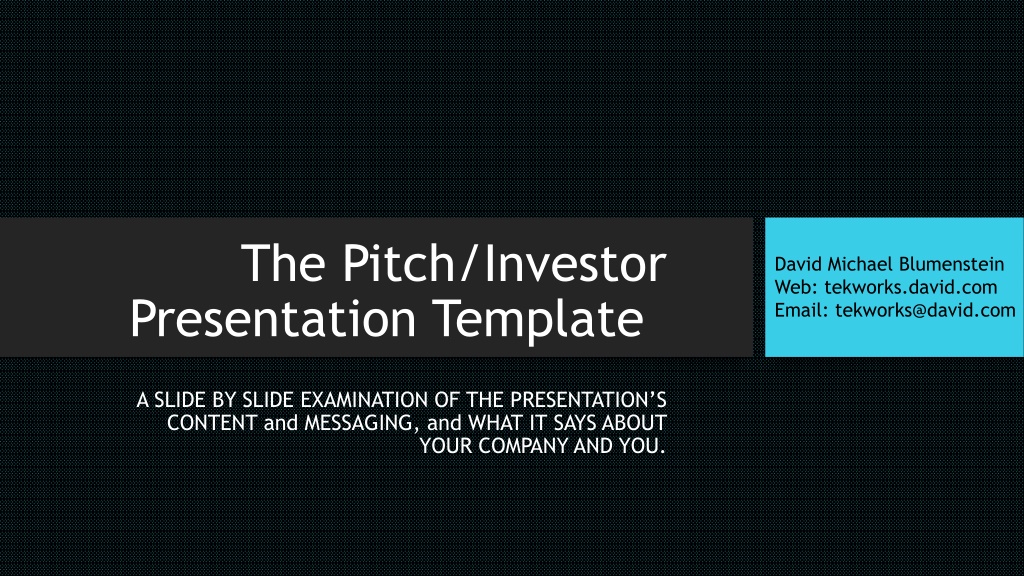














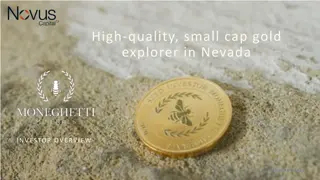
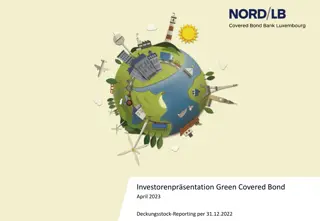

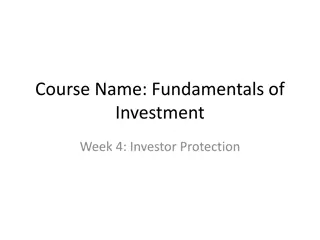

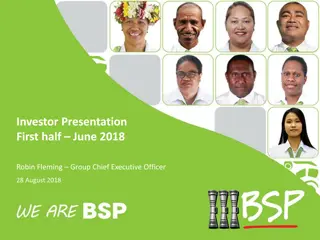
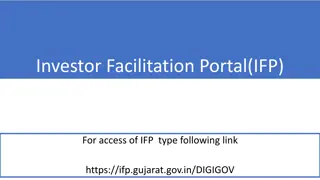

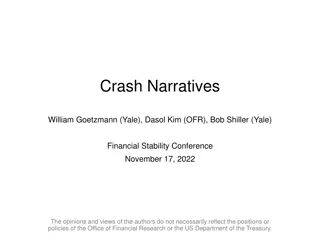

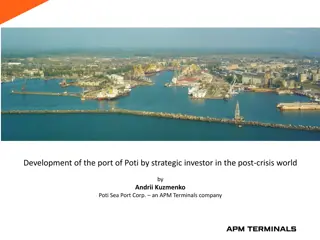


![Innovative Solutions for Investor Success - [Your Name] & [Your Company Name]](/thumb/196869/innovative-solutions-for-investor-success-your-name-your-company-name.jpg)

